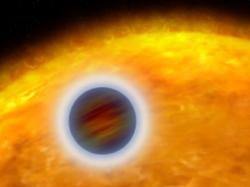 Now here’s a feat. The Hubble Space Telescope was able to analyze the atmosphere of a gas giant planet orbiting another star.
Now here’s a feat. The Hubble Space Telescope was able to analyze the atmosphere of a gas giant planet orbiting another star.
Hubble’s instruments revealed how the strange world, designated HD 209458b, is unlike anything else in our solar system. It orbits its parent star so closely that it only takes 3.5 days to complete an orbit. This close proximity raises its temperature above the temperature of our own Sun, and causes its outer atmosphere to boil off. If we could see it with our eyes, we would see a comet-like tail trailing behind.
Even though it’s losing a tremendous amount of material, it’s got plenty. Astronomers calculate that it should be able to continue losing material for another 5 billion years.
This analysis was performed using the planetary transit method, where the planet passes in front of its parent star on a regular basis. Astronomers can analyze the structure of the planet’s atmosphere by measuring the light from the star that passes through it.
Original Source: Hubble News Release
